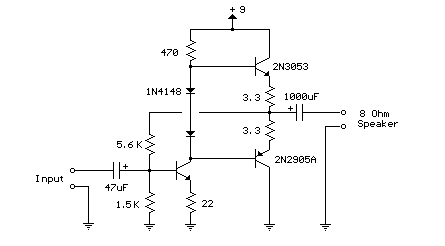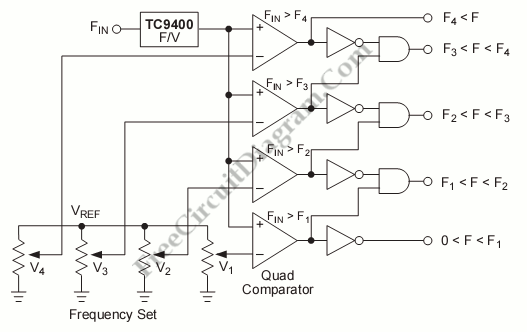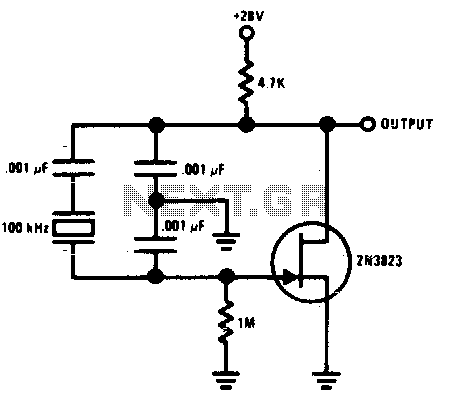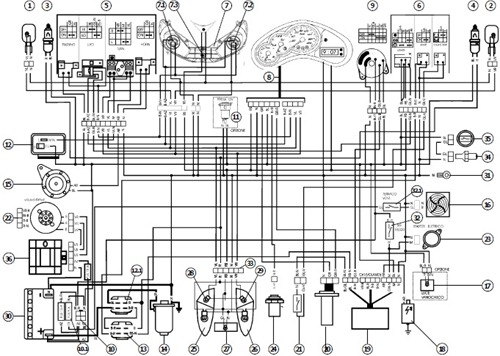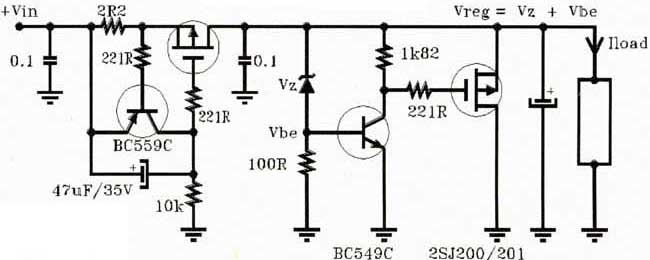
Frequency counter Input schematic
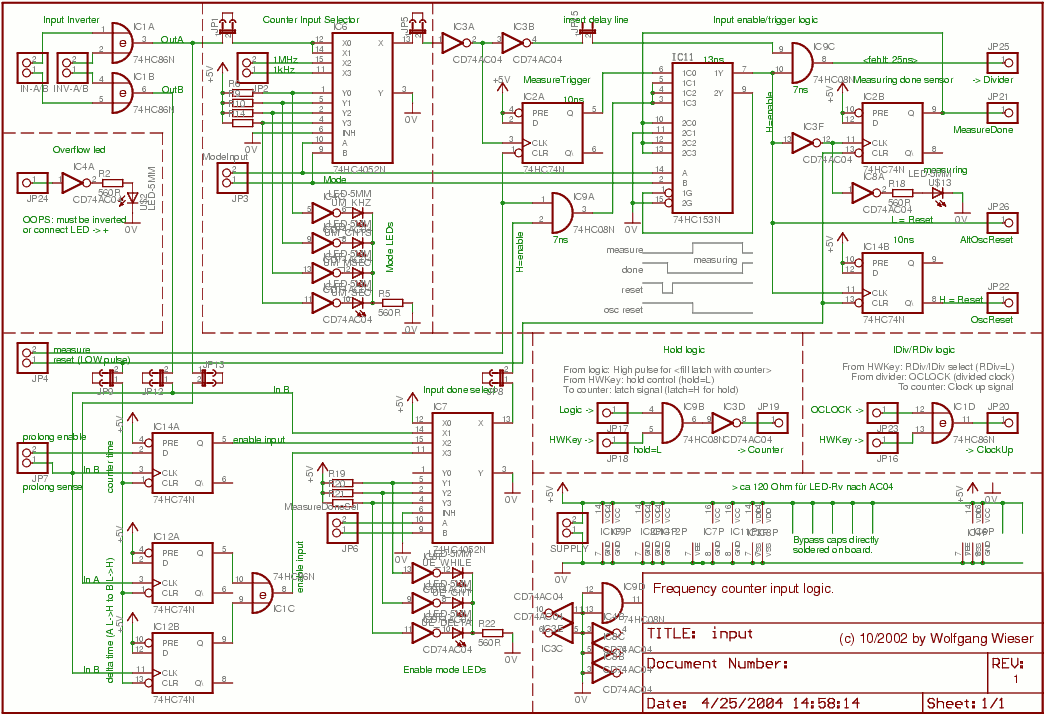
The master mode selection switch is IC6, which controls the four mode LEDs that correspond to the measured units: kHz, counts, milliseconds, or seconds. In standard frequency counter mode (mode 0, unit: kHz) and counter mode (mode 1, unit: counts), input A is utilized for the divider and counter. For both time measurement modes (mode 2 and 3; units: milliseconds and seconds), fixed clock sources of 1 MHz and 1 kHz are employed. An additional switch, IC9C, acts as a gate to regulate the duration for which the output from the master mode switch is connected to the divider and counter. The enable input (pin 10) of IC9C is controlled by IC11. In counter and time measurement modes, this enable input is derived from the AND gate (IC9A) that combines the measurement signal from the logic board and the enable signal from the enable logic located in the lower left of the schematic. For frequency counter mode, this enable logic is not applicable; instead, IC2A, an edge-triggered D-type flip-flop, ensures that measurement commences at a HIGH-to-LOW transition of the input signal. This is facilitated by two inverters, IC3A and IC3B. When the measurement signal from the logic board is LOW, flip-flop IC2A is reset (pin 1), providing functionality similar to that of the IC9A AND gate in other modes. To detect when the measurement is complete, the "measuring done sensor" IC2B activates on the HIGH-to-LOW transition of the enable signal (pin 7 of IC11). A feedback loop from pin 9 to pin 1 of IC11 ensures that once the measurement concludes (IC2B’s pin 9 outputs HIGH to pins 10, 12, and 13 of IC11), it does not restart until a reset pulse is received from the logic board. Notably, no such feedback is incorporated for counter mode. In time measurement and frequency counter modes, IC14B plays a crucial role by ensuring that the 1 kHz oscillator activates precisely when the enable signal (pin 7 of IC11) goes HIGH, allowing the nth 1 kHz clock tick to complete exactly n milliseconds after measurement initiation. This is also applicable in frequency counter mode, where the microcontroller on the logic board counts 100 to 10,000 ticks of the 1 kHz clock (gate times of 0.1 to 10 seconds) to determine when to terminate the measurement. Without this synchronization, an error of 0 to 1 millisecond could occur. It is important to note that the 1 MHz clock used in the other (millisecond) time measurement mode does not have such synchronization, resulting in a maximum error of 1 microsecond. This clock also serves to clock the microcontroller on the logic board. To conclude an ongoing measurement, the logic board can set the enable signal to LOW, which is the only method for frequency counter mode, as the microcontroller utilizes the 1 kHz clock for gate timing. Alternatively, the enable logic (located in the lower left of the schematic) may decide to terminate the measurement. In all cases, the microcontroller is notified of the measurement's conclusion via the measuring done signal on JP21. The enable logic comprises the enable mode selector IC7 (with corresponding LEDs) and three edge-triggered D-type flip-flops IC14, IC12A, and IC12B. Enable mode 0 (standard) signifies "enable always" (pin 12 of IC7), while mode 1 means "enable as long as input B is HIGH." Modes 2 and 3 are more intricate: Mode 2 employs IC14 to alter the enable signal upon a LOW-to-HIGH transition of input B. The logic board maintains some control, providing the D input of the flip-flop, allowing for measurements of 1, 10, or 100 pulses of a signal on input B by counting 0, 9, or 99 pulses, then setting the D input to LOW so that the next rising edge of input B will halt the measurement.
The circuit utilizes a master mode selection switch (IC6) that effectively manages the operation of the frequency counter and time measurement system. The four mode LEDs indicate the current measurement unit, which corresponds to different operational modes. The switch's output is routed through IC9C, an AND gate that controls the connection to the divider and counter based on the selected mode. The architecture ensures that the measurement process is tightly controlled through the use of IC11, which provides the necessary enable signals to the measurement logic.
The integration of flip-flops (IC2A, IC12A, IC12B, and IC14) allows for precise timing and control over measurement initiation and termination. The feedback mechanism prevents erroneous re-triggering of measurements, ensuring reliability in the system's performance. The use of dedicated clock sources (1 MHz and 1 kHz) ensures accurate timing for both frequency counting and time measurement, while the microcontroller's role in processing the measurement results is critical for the overall functionality of the device.
The enable logic section, comprising IC7 and additional flip-flops, provides a flexible interface for controlling measurement modes, allowing for dynamic adjustments based on the input signals. This feature is particularly useful for applications requiring precise timing and counting capabilities. Overall, the circuit design reflects a thoughtful approach to managing complex measurement tasks, ensuring accuracy and reliability across various operational modes.The master mode selection switch is IC6 which switches the 4 mode LEDs (which also correspond to the measured unity, i. e. kHz, counts, milli-seconds or seconds) as well as the input for the divider and the counter : For standard frequency counter mode (mode: 0, unity: kHz) as well as counter mode (mode: 1, unity: counts), the input A is used (for
divider, etc); for both time measurement modes (mode: 2, 3; unity msec, seconds), the fixed 1MHz and 1kHz clock sources are used. This, of course, requires that there is another switch which acts as a gate to control exactly how long the output of the master mode switch is conntected to the divider and counter : This is IC9C, an AND gate whose enable input (pin10) is controlled by IC11: In counter and time measurement modes, this enable input is simply the AND (IC9A) of the measure signal from the logic board and the enable signal from the enable logic (left bottom in the sheet).
For frequency counter mode, this enable logic has no use but here, the IC2A edge-triggered (D-type) flip-flop makes sure that the measurement actually starts at a HIGH-to-LOW transition of the input signal (this is the reason for the 2 inverters IC3A, B. When the measure signal from the logic board is LOW, the flip flop IC2A is reset (pin1) and hence provides similar functionality as the IC9A AND gate for the other modes.
frequency counter mode, the In order to detect when measurement is finished, the "measuring done sensor" IC2B is used which triggers on the HIGH-to-LOW transition of the enable signal (IC11`s pin7). Especially note the "feedback loop" from pin9 to pin1 of IC11 which makes sure that once the measurement is finished (i.
e. IC2B`s pin9 feeds HIGH into IC11`s pins 10, 12, 13), it is not re-started again before there was a reset pulse on the reset line delivered by the logic board. (For obvious reason, no such feedback is provided for counter mode. ) For time measurement mode and frequency counter mode, IC14B plays an important role: It makes sure that the 1kHz oscillator starts running just at the time when the enable signal (IC11`s pin7) goes HIGH so that the n-th 1kHz clock tick is finished exactly n msec after the start of the measurement.
(This holds also for frequency counter mode where the microcontroller on the logic board counts 100 to 10000 ticks of the 1kHz clock (i. e. gate times of 0. 1 to 10 seconds) to decide when to end the measurement. ) Otherwise an error of 0 to 1 msec would be introduced. Note also that no such synchronisation is provided for the 1MHz clock of the other (msec) time measurement mode which means that it always has an error of max.
1usec. (This clock is also needed to clock the microcontroller on the logic board. ) In order to end a running measurement, either the logic board sets the enable signal to LOW (which is the only method for frequency counter mode: the microcontroller here uses the 1kHz clock for the gate timing) or when the enable logic (on the left bottom of the sheet) decides to do so. In any case, the microcontroller is informed about the end of the measurement via the measuing done signal on JP21.
The enable logic on the left bottom of the sheet is formed of the enable mode selector IC7 (with corresponding LEDs) and the 3 edge-triggered D-type flip-flops IC14, IC12A and IC12B. Enable mode 0 (standard) means "enable always" (IC7`s pin12) while mode1 means "enable as long as input B is HIGH".
The modes 2 and 3 are more complex: Mode2 uses IC14 to make the enable signal change upon a LOW-to-HIGH transition of the inputB. Note that the logic board has rough control over it since it provides the D input of the flip-flop. This allows to e. g. measure the time of 1, 10 or 100 pulses of some signal on inputB by using the logic to count 0, 9 or 99 pulses and then set prolong (the D input) to LOW so that the next rising edge of inputB will actually stop the measurement.
Mode3 finally allows to 🔗 External reference
The circuit utilizes a master mode selection switch (IC6) that effectively manages the operation of the frequency counter and time measurement system. The four mode LEDs indicate the current measurement unit, which corresponds to different operational modes. The switch's output is routed through IC9C, an AND gate that controls the connection to the divider and counter based on the selected mode. The architecture ensures that the measurement process is tightly controlled through the use of IC11, which provides the necessary enable signals to the measurement logic.
The integration of flip-flops (IC2A, IC12A, IC12B, and IC14) allows for precise timing and control over measurement initiation and termination. The feedback mechanism prevents erroneous re-triggering of measurements, ensuring reliability in the system's performance. The use of dedicated clock sources (1 MHz and 1 kHz) ensures accurate timing for both frequency counting and time measurement, while the microcontroller's role in processing the measurement results is critical for the overall functionality of the device.
The enable logic section, comprising IC7 and additional flip-flops, provides a flexible interface for controlling measurement modes, allowing for dynamic adjustments based on the input signals. This feature is particularly useful for applications requiring precise timing and counting capabilities. Overall, the circuit design reflects a thoughtful approach to managing complex measurement tasks, ensuring accuracy and reliability across various operational modes.The master mode selection switch is IC6 which switches the 4 mode LEDs (which also correspond to the measured unity, i. e. kHz, counts, milli-seconds or seconds) as well as the input for the divider and the counter : For standard frequency counter mode (mode: 0, unity: kHz) as well as counter mode (mode: 1, unity: counts), the input A is used (for
divider, etc); for both time measurement modes (mode: 2, 3; unity msec, seconds), the fixed 1MHz and 1kHz clock sources are used. This, of course, requires that there is another switch which acts as a gate to control exactly how long the output of the master mode switch is conntected to the divider and counter : This is IC9C, an AND gate whose enable input (pin10) is controlled by IC11: In counter and time measurement modes, this enable input is simply the AND (IC9A) of the measure signal from the logic board and the enable signal from the enable logic (left bottom in the sheet).
For frequency counter mode, this enable logic has no use but here, the IC2A edge-triggered (D-type) flip-flop makes sure that the measurement actually starts at a HIGH-to-LOW transition of the input signal (this is the reason for the 2 inverters IC3A, B. When the measure signal from the logic board is LOW, the flip flop IC2A is reset (pin1) and hence provides similar functionality as the IC9A AND gate for the other modes.
frequency counter mode, the In order to detect when measurement is finished, the "measuring done sensor" IC2B is used which triggers on the HIGH-to-LOW transition of the enable signal (IC11`s pin7). Especially note the "feedback loop" from pin9 to pin1 of IC11 which makes sure that once the measurement is finished (i.
e. IC2B`s pin9 feeds HIGH into IC11`s pins 10, 12, 13), it is not re-started again before there was a reset pulse on the reset line delivered by the logic board. (For obvious reason, no such feedback is provided for counter mode. ) For time measurement mode and frequency counter mode, IC14B plays an important role: It makes sure that the 1kHz oscillator starts running just at the time when the enable signal (IC11`s pin7) goes HIGH so that the n-th 1kHz clock tick is finished exactly n msec after the start of the measurement.
(This holds also for frequency counter mode where the microcontroller on the logic board counts 100 to 10000 ticks of the 1kHz clock (i. e. gate times of 0. 1 to 10 seconds) to decide when to end the measurement. ) Otherwise an error of 0 to 1 msec would be introduced. Note also that no such synchronisation is provided for the 1MHz clock of the other (msec) time measurement mode which means that it always has an error of max.
1usec. (This clock is also needed to clock the microcontroller on the logic board. ) In order to end a running measurement, either the logic board sets the enable signal to LOW (which is the only method for frequency counter mode: the microcontroller here uses the 1kHz clock for the gate timing) or when the enable logic (on the left bottom of the sheet) decides to do so. In any case, the microcontroller is informed about the end of the measurement via the measuing done signal on JP21.
The enable logic on the left bottom of the sheet is formed of the enable mode selector IC7 (with corresponding LEDs) and the 3 edge-triggered D-type flip-flops IC14, IC12A and IC12B. Enable mode 0 (standard) means "enable always" (IC7`s pin12) while mode1 means "enable as long as input B is HIGH".
The modes 2 and 3 are more complex: Mode2 uses IC14 to make the enable signal change upon a LOW-to-HIGH transition of the inputB. Note that the logic board has rough control over it since it provides the D input of the flip-flop. This allows to e. g. measure the time of 1, 10 or 100 pulses of some signal on inputB by using the logic to count 0, 9 or 99 pulses and then set prolong (the D input) to LOW so that the next rising edge of inputB will actually stop the measurement.
Mode3 finally allows to 🔗 External reference
